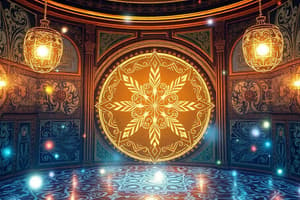Podcast
Questions and Answers
किसका उपयोग हम बत्ती के उत्पादन के लिए करते हैं?
किसका उपयोग हम बत्ती के उत्पादन के लिए करते हैं?
- गहरी स्लिट
- परावर्तन
- अंतः प्रकाश
- सूर्य (correct)
क्या एक गहरी स्लिट के साथ प्रकाश का परावर्तन बनाता है?
क्या एक गहरी स्लिट के साथ प्रकाश का परावर्तन बनाता है?
- परावर्तन (correct)
- दिक्क
- सूर्य
- प्रकाश
प्रकाश के बेंडिंग, प्रतिबिम्बन, और परावर्तन के सिद्धांतों को समझने से क्या हमें मिलता है?
प्रकाश के बेंडिंग, प्रतिबिम्बन, और परावर्तन के सिद्धांतों को समझने से क्या हमें मिलता है?
- सूंघन प्रक्रिया की समझ
- मानवता में आलोक के महत्व की भावना
- प्रकाशिकी के सिद्धांतों की समझ (correct)
- विद्युत प्रक्रिया की समझ
होलोग्राफी और इंटरफेरोमेट्री कौन-कौन से आविष्कारों की बुनियाद हैं?
होलोग्राफी और इंटरफेरोमेट्री कौन-कौन से आविष्कारों की बुनियाद हैं?
किस प्रक्रिया के द्वारा प्रकाश किसी सतह से टकराता है और दिशा बदलता है?
किस प्रक्रिया के द्वारा प्रकाश किसी सतह से टकराता है और दिशा बदलता है?
किस विज्ञान का अध्ययन प्रकाश के साथ कैसे प्रभाव करता है और इसे हमारी आवश्यकताओं के अनुसार संचालित किया जा सकता है?
किस विज्ञान का अध्ययन प्रकाश के साथ कैसे प्रभाव करता है और इसे हमारी आवश्यकताओं के अनुसार संचालित किया जा सकता है?
किस प्रक्रिया में प्रकाश को एक अवरोधी के चारों ओर से होकर फैलाया जाता है?
किस प्रक्रिया में प्रकाश को एक अवरोधी के चारों ओर से होकर फैलाया जाता है?
समतल और समरूप मिरर पर प्रकाश कैसे प्रतिबिम्बित होता है?
समतल और समरूप मिरर पर प्रकाश कैसे प्रतिबिम्बित होता है?
Flashcards are hidden until you start studying
Study Notes
Light: A Journey Through Reflection, Optics, Diffraction, and Light Sources
Light is the fundamental force that illuminates our world and enables our daily lives. It's an intricate dance of photons, moving through space and interacting with matter to create the dazzling spectacle of the universe.
Reflection
Reflection is the process by which light bounces off a surface, changing direction as it does so. This bounce can occur at any angle, resulting in the formation of images. When light strikes a smooth and flat mirror, it reflects off at a similar angle, forming a virtual image that is flipped horizontally and located behind the mirror.
This principle is used to create reflective surfaces, such as mirrors, to enhance our ability to see ourselves and the world around us.
Optics
Optics is the science of light, examining how it interacts with matter and is manipulated to suit our needs. Optical devices, such as lenses and mirrors, are specifically designed to control, refract, and direct light, making it possible to create images and reveal details.
From magnifying glasses and binoculars to complex microscopes and telescopes, optics lies at the heart of many tools that help us observe and analyze our surroundings.
Diffraction
Diffraction is the bending or spreading of light as it passes around or through an obstruction. When light encounters an opaque object, such as a narrow slit or a grating, it creates a diffraction pattern that can be used to understand the nature of light and its interactions with matter.
From rainbows to the patterns of interference, diffraction is a fascinating phenomenon that reveals the wave-like nature of light and is the basis of many applications, such as holography and interferometry.
Light Sources
Light sources are the origin points of illumination, providing the energy that fuels our visual world. From sunflowers tracking the sun to the LED lights that brighten our homes, light sources come in a variety of forms, each with its unique properties and applications.
Incandescent bulbs, fluorescent lights, and solar panels are just a few examples that illustrate the diverse and innovative ways we harness the power of light.
Conclusion
Understanding the principles of reflection, optics, diffraction, and light sources gives us a deeper appreciation for the beauty and complexity of light itself. By exploring these fundamentals, we can create various tools and technologies to improve our lives, expand our knowledge, and illuminate our ever-growing understanding of the universe.
So, the next time you admire a brilliant rainbow or marvel at an intricate microscope image, remember that at the heart of it all is light, bending, reflecting, and diffracting to bring us the wonders of the world.
Studying That Suits You
Use AI to generate personalized quizzes and flashcards to suit your learning preferences.




